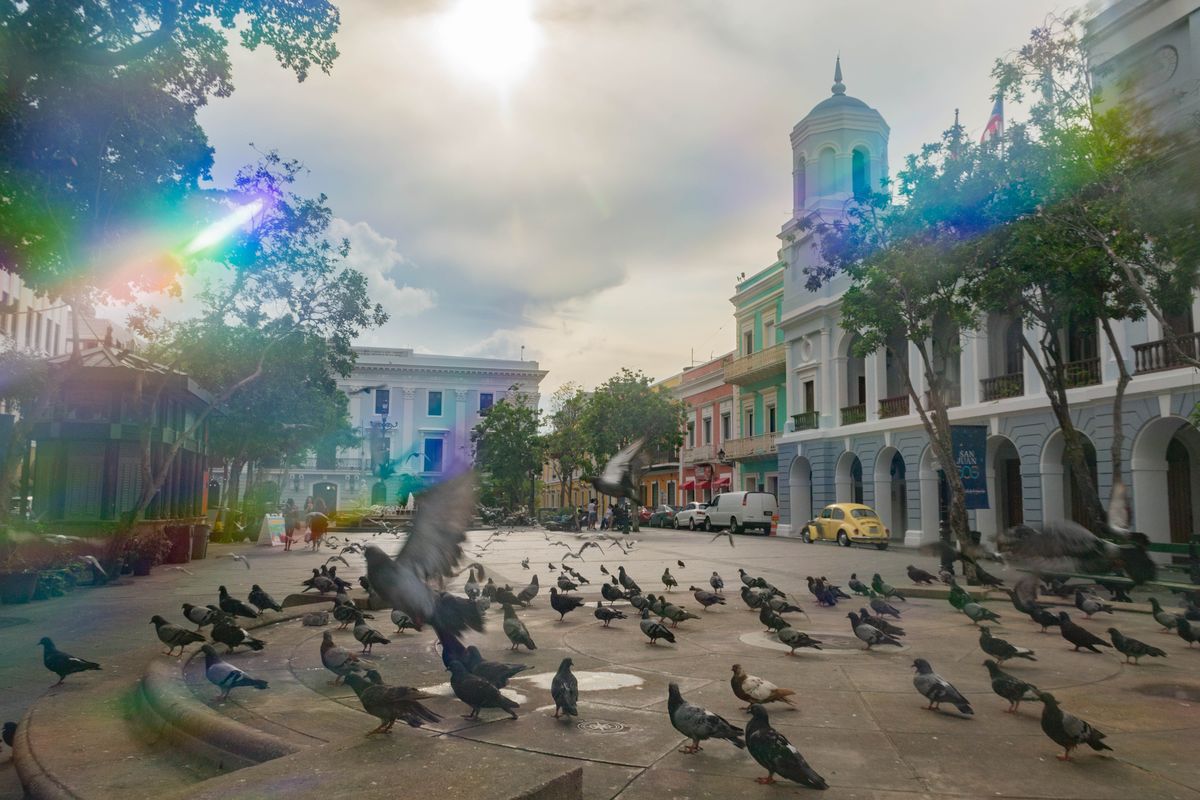This historic San Juan walking tour is an architecture lover’s dream

The city within a city of Old San Juan, Puerto Rico, acts as a time capsule.
Since the Spanish settled there in 1519, the district’s buildings, plazas and fountains have been built in a medley of architectural styles – Gothic, baroque, art deco, modern and more – a snapshot of Spanish and American aesthetics during colonial rule.
Wandering the cobblestone streets of Old San Juan, at the western tip of San Juan’s northernmost islet, one can vividly trace its evolutions, from the medieval and Renaissance sensibilities of its Conquest Period to today. The district’s 74 blocks are packed with celebrated architecture and monuments to Puerto Rican culture, including some of the oldest buildings in the United States.
Here’s how you can take your own walking tour of Old (or Viejo) San Juan and see 500 years of architectural history come alive.
Antiguo Casino de Puerto Rico
The 19th century Plaza Colón, named for its marble Christopher Columbus statue, marks the main entrance to Old San Juan, and you will find another gem just to the east: the Antiguo Casino de Puerto Rico.
Named to the National Register of Historic Places in 1977, the casino was built in the 1910s in the Beaux-Arts style popularized by 19th century Paris. Among its distinctive features: a mansard bronze roof, Tiffany-style glass windows and white marble floors and walls.
These days, it is an event space and wedding venue.
The Forts
Walking up Calle de Norzagaray (also known as Bulevar del Valle) from Plaza Colón, you will come upon Castillo de San Cristóbal, named after Saint Christopher, patron saint of travelers. The largest fortress built in the Americas, spanning 27 acres, it was constructed over the course of more than 150 years to protect the city against land attacks from the east.
As you continue down Norzagaray, look to the northwestern point of the island to see the islet’s second fortress, Castillo San Felipe del Morro, topped by the oldest lighthouse in existence in Puerto Rico. A six-level triangular fort, “El Morro” has welcomed ships entering the bay since the beginning of its construction in 1539.
Iglesia de San José
Detouring down Calle del Cristo, you will find the recently renovated Iglesia de San José, originally built in 1532, making it the second-oldest standing church in the Americas.
San José is one of the few surviving examples of 16th century Spanish Gothic architecture in the Western Hemisphere, and it’s the oldest example of it in the United States, with floors of gray marble, a gold altar and frescoes in the vaults. One fresco is of armored mermaids, but the story behind them remains unknown.
Cuartel de Ballajá
This foreboding, three-story structure was built by the Spanish Army between 1854 and 1864 to serve as a residence for military officers. It cost so much money, it’s said, that Queen Isabel II asked whether it was being constructed in silver. It wasn’t, but its classical exterior is indeed luxe.
The building now houses cafes on its first floor, which opens up to an internal court surrounded by an arcade known as a cortile, characteristic of a Renaissance-era Italian palace. Marble stairs lead to the Museum of the Americas on the second floor.
Casa Blanca
Built in 1521, Casa Blanca served as the first fortification in Viejo San Juan and was home to conquistador Juan Ponce de León and his descendants until the mid-18th century.
The house was originally built in wood, but after a fire, it was rebuilt in stone and masonry in the medieval architectural style of the casa torre, or tower house – characterized by its castle-style towers, as well as small openings for observation and protection.
Furnished with 16th century Castilian pieces, Casa Blanca and its serene gardens are now a museum open to the public.
Plaza de Armas
Plaza de Armas is considered the heart of Old San Juan, as the seat of municipal and Puerto Rican government since the 17th century. But the plaza, a tribute to the main squares of Spain, could also be the unofficial seat of the district’s architectural diversity: On nearly every side of it, you’ll find a wonder.
In the plaza’s northwest wing, visitors can admire Casa Alcaldía, a replica of Madrid’s city hall, complete with a 19th century neoclassical facade, Elizabethan-style lights and a clock tower of Enlightenment influence.
To the west is the Antiguo Palacio de la Real Intendencia, which now holds Puerto Rico’s Department of State Office, styled after an Italian high palace. And on the south side of the plaza, you will be transported to a different era with a clear American influence.
González Padín, for instance, features big “Chicago windows” that emulate the department store culture in the great cities of the United States at the beginning of the 20th century.
Banco Popular
Calle de Tetuán became known as a financial center in the 20th century and the most prominent and still operating bank on the block is the art deco Banco Popular.
At the time it was finished, in 1939, the bank was the tallest building on the island, but it offers more than scale: There are infusions of bronze, cubist eagles in the curved facade facing the bay and a towering stained-glass window that depicts the shield of San Juan.
Reliefs of Greek and Roman gods flank the glass, a fitting ode to the architectural influences and ambitions of the district.